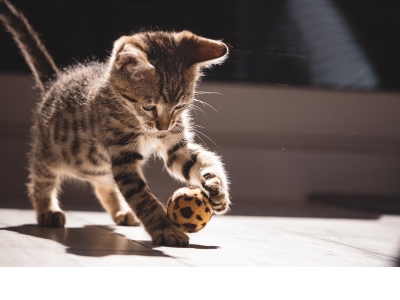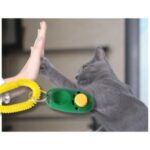Environmental Enrichment

One thing that zoos do really well is provide activities and opportunities for animals to perform natural behaviors and work for their food.
This focus on enrichment:
- Decreases anxious and abnormal behaviors often seen in captive animals
- Reduces stress and boredom
- Improves physical fitness
- Provides mental stimulation
- Increases social interaction in social animals
Our cats need the opportunity to express their “inner tiger”.
We can think of house cats like miniature captive wild cats that have natural instincts and behaviors that often aren’t satisfied in a home environment, especially a fully indoor home. They can be bored, stressed and develop behavior problems. Obesity and other physical problems related to a lack of movement are a huge problem in cats, and lead to shorter, less comfortable lives.
It is estimated that almost 60% of pet cats are overweight or obese.

❝
“Millions of indoor cats are likely clinically depressed. Doing nothing all day, every day is not normal”
Dr. Karen Overall, veterinary behaviorist and author of one of the most widely known textbooks about behavior in pets.
But our house cats aren’t really like wild cats, are they?
Our pet cats were likely domesticated from the African Wildcat (Felis silvestris lybica) about 9000 years ago in the Middle East. This is relatively recent compared to dog domestication (15,000 – 40,000 years ago). There is only a small genetic divergence between African wildcats and domestic cats, meaning the same instincts and behaviors are within our modern day pets.

African Wildcat
What are the natural behaviors and instincts?
- Hunting: stalking, hiding, pouncing
- Exploring and marking large territories, with different scents and challenges
- Climbing and scratching
- Grooming
- Interacting with other animals: avoiding predators, territorial disputes, finding mates

The typical environment and life of our pet cats is often the exact opposite of this natural life. They are in smaller, more predictable environments, with no need to hunt for food. The interactions with other animals are much different as well.
This was the usual life for a zoo animal until growing awareness of animal welfare and a deeper understanding of animal behavior brought about the common practice of environmental enrichment in the 1970’s and 1980’s. It is now standard practice in most zoos around the world.
We can also improve the lives of our much loved cats with a few simple changes.
What can happen with our kitties in our homes without consideration of their natural needs?
- Scratching and destruction of furniture
- Meowing, yowling, or crying excessively, seeking attention or expressing frustration.
- Urinating or defecating outside the litter box
- Inflammation of the bladder (interstitial cystitis) from an abnormal response to stress, leading to pain and bloody urine
- Aggression toward other pets or people
- Overgrooming
- Lethargy, depression or avoidance, showing little interest in playing or interacting with their environment
- Weight gain and lack of physical fitness
What can we provide for our cats?
Short and Fun Play Sessions With Interactive Toys: Provide a variety of toys that stimulate play, such as wand toys, laser pointers, and puzzle feeders. These encourage exercise and mental engagement by mimicking hunting behaviors.
Climbing Structures: Install cat trees, shelves, or perches that allow cats to climb and explore vertically. Climbing satisfies their natural instincts and offers them a vantage point to observe their environment.
Scratching Posts: Offer scratching posts or pads to satisfy their natural need to scratch. These should be placed in different areas of the home to encourage regular use and to help prevent furniture destruction.
Hiding Spots and Cubes: Provide enclosed spaces like cat tunnels, boxes, or cozy beds where cats can retreat and feel secure. These hideouts cater to their instinctual need for safe, quiet spaces.
Varied Environment: Introduce different scents, sounds, and textures to the environment. This could include catnip, pheromone diffusers, or safe outdoor exploration (like a catio or harness walks) to stimulate their senses and curiosity.

A Job:
One great way to add a challenge to a cat’s life is to make him work for his food.
We think we are doing our pets a favor by providing easy food in a bowl, but what they really need to be healthy is a job. The work can be as simple as getting food out of a puzzle feeder, running after tossed kibbles, or finding hidden food.
Puzzle feeders for cats are very popular and can be purchased or homemade. Many different styles exist.

The website Food Puzzles For Cats shows many different commercial variations and instructions for homemade feeders, made out of common household items.
Another great resource is the Indoor Cat Initiative of the Ohio State University University of Veterinary Medicine. This website goes into details about the needs of indoor cats, with a special focus on problem solving litter box and interstitial cystitis problems.
A few fun and simple changes in your cat’s life and environment could make a world of difference!




